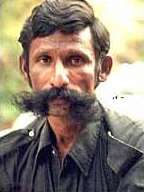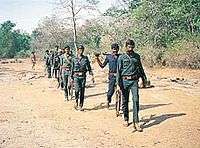Operation Cocoon
Operation Cocoon was the operation launched by the Special Task Force of Tamil Nadu Police to nab the forest brigand Veerappan and his associates, who were dominant in Sathyamangalam Forest in the South Indian states of Tamil Nadu, Karnataka and Kerala. The operation was headed by the then Superindent of Police, Vijay Kumar. Veerappan was shot dead in the operation on 18 October 2004 along with three of his associates, Sethukuli Govinda, Chandre Gowda and Sethumani, while four policemen were injured.
Veerappan defied the state governments of Karnataka, Tamil Nadu and Kerala and Indian Border security paramilitary forces, and maintained a small army, which at one point numbered hundreds. He was wanted for killing approximately 184 people, about half of whom were police officers, including senior police and forest officials. He was also wanted for poaching about 200 elephants and smuggling ivory worth US$2,600,000 and about 10,000 tonnes of sandalwood worth approximately US$22,000,000.
The joint Special Task Force (STF) operation of Veerappan, constituted in 1991 by the state governments of Tamil Nadu and Karnataka, is considered one of the costliest in Indian history, consuming ₹1 billion over the years.
Background

Veerappan (Koose Muniswamy Veerappan,[1] 18 January 1952 – 18 October 2004), also called "Sandalwood Veerappan", was an Indian bandit (also called a dacoit in India) who was active for years in scrub and forest lands covering about 6,000 km² in the states of Karnataka, Kerala and Tamil Nadu. For over a decade, Veerappan defied the state governments of Karnataka, Tamil Nadu and Kerala and Indian Border security paramilitary forces, and maintained a small army, which at one point numbered hundreds. He was wanted for killing approximately 184 people, about half of whom were police officers, including senior police and forest officials.[2] During his video interview with Nakkeeran editor R. Gopal, he confessed to the 120 murders he committed. While his initial days of dacoity were restricted to satisfying his financial needs, his later actions included demand of release of militants from jail in exchange of the hostages.[3]
Veerappan first came in news when he murdered Chidambaram, a forest officer who was against his illegal trade. In 1991, he shot P Srinivas, a Karnataka Deputy Conservator of Forests and beheaded in a Kali temple. During the subsequent years, he killed tens of police officers and tribal people, whom he felt, were against his illegal trade. In 1997, he kidnapped Karnataka forest officers and after lot of negotiations with Nakkeeran editor Gopal, he released them. In the same year, he kidnapped 21 tourists, but later released them without any harm.[4] He came to national limelight when he kidnapped the Kannada actor Rajkumar during 2000.[5][6] His last big crime was in 2000, when he abducted Nagapppa, a retired minister of Karnataka. Nagappa was found dead in the forest later, but Veerappan denied his killing.[4] He was also wanted for poaching about 200 elephants and smuggling ivory worth US$2,600,000 and about 10,000 tonnes of sandalwood worth approximately US$22,000,000. A reward of ₹50 million (US$740,000) was offered for Veerappan's capture, yet he evaded arrest for 20 years until he was killed by police in 2004.[7]
The operation

The joint Special Task Force (STF) operation of Veerappan, constituted in 1991 by the state governments of Tamil Nadu and Karnataka, is considered one of the costliest in Indian history, consuming ₹1 billion over the years.[4] The operation involved infiltration by the police men into enemy camp with the help of tribal people. Since Veerappan was aware of the terrain of the forest, it was planned to bring him out of the forest.[8] As per the report of police, the report was planned for ten months, the execution took 3 weeks and the final operation lasted only 45 minutes. STF personnel infiltrated as hawkers, masons and local service staff in the villages where Veerappan was supposedly roaming. Down the years, due to ageing and others getting killed, his troop was reduced to four men. Veerapan was planning to take a medical treatment for his eye in South Arcot and was planning to flee out of the forest.[4] On the day of the operation, Veerapan was escorted out of the forest to the ambulance stationed at Papirappati village in Dharmapuri district, which was a police vehicle, by one of the police who earlier infiltrated his gang. A 35 member troop was stationed in the village, a few security men were hiding in security tankers in the road and others were hiding in the bushes. The driver of the ambulance, who was also a policeman, made an escape. As per police report, Veerappan and his gang were first warned and then asked to surrender, which was denied and the gang started firing at the STF personnel. The STF retaliated by firing grenades and gun fire. Veerappan was killed on the spot, while his gangmen died on the ambulance taking them to the government hospital. After the operation, the STF recovered 12 bore Remington pump action gun, two AK-47, a self-loading rifle, two hand grenades and cash worth ₹3.5 lakhs.[9]
The file photograph released by the police indicated three bullet shots on him, one each in forehead, hip and ribs. His body was kept in the Dharampuri hospital where scores of people came in to view his body, though they were not allowed to. Police found it difficult to control the crowd outside the hospital.[3] There was a brief controversy about the burial as the wife of Veerappan, Muthulakshmi, was against cremation and wanted it to be placed in the house of Veerappan's brother. They also claimed that the right to perform the final rites rested with the family.[10]
Controversies
"We have searched and hunted for Veerappan for the last 20 years. But his end was all over in 20 minutes. We wish we could catch him alive and bring him to justice. But we are happy that our efforts have finally succeeded"
The operation of killing Veerappan raised various controversies. It was alleged that the person who got killed in the encountered was not Veerappan as he used to have a bigger mustache. Police established his identity with fingerprints and also with confirmation with his relatives. The nature of the gunshots were alleged to be mismatching with the version narrated by the police involved in the encounter. But it was proven from the post mortem reports and ballistic experts that it matched the version of the narration. Some section of the media claimed that Veerappan could have been captured alive and that he was murdered only for political reasons. They also claimed that capturing him alive and subjecting him to trial could have brought out several unknown truth. But it was clarified by the police that fire had to be opened for retaliation. There were also outcry from human rights activists that Veerappan was not given a fair chance to justify himself.[8]
Aftermath
All the police officers involved in the operation were rewarded by the Tamil Nadu government. Some of the officers who were directly involved in the operation received double promotion. His life and the operation was an inspiration of two Bollywood movies. A 125 episode tele serial named Santhanakadu on the life of the brigand was telecast in Makkal TV in 2007 and it drew lot of controversy. Veerappan's widow, Muthulakshmi, filed a case in a sessions court against the telecast as it would demean her family, but lost the case.[11] Jungle Lodges and Resorts Limited, a Karnataka government undertaking, launched 11 new jungle camps during 2010, with one of them covering Gopinatham, where Veerappan lived. The tourism involved trek through the vast BR and MM hills and a narration of the places where Veerapan lived and held people in hostage by a trained local guide.[12] K Vijaya Kumar was awarded the President's gallantry medal in 2005 for the operation.[13] In 2016, Ram Gopal Varma directed, a docudrama film Killing Veerappan, highlighting the role of K Vijay Kumar, and N. K. Senthamarai Kannan in the operation.[14][15]
Notes
- ↑ "Bandit's footprints". The Economic Times. TNN. 19 October 2004. Retrieved 11 December 2012.
- ↑ "Veerappan - The Man Behind 120 Murders: HindustanTimes.com Special". Hindustantimes.com. Retrieved 19 September 2010.
- 1 2 "Koose Muniswamy Veerappan: The Bandit King He has been described as India's answer to Robin Hood. But Koose Muniswamy Veerappan was a ruthless killer who admitted to 120 murders before he died in a hail of police bullets on Monday. Justin Huggler tries to sort the facts from the fiction in a life that has already become legend". Belfast Telegraph. 20 October 2004. Retrieved 1 January 2014. – via HighBeam (subscription required)
- 1 2 3 4 5 "India's most wanted, Veerappan shot dead". India Abroad. 20 October 2004. Retrieved 1 January 2014. – via HighBeam (subscription required)
- ↑ Krupakar 2011 , p. 7
- ↑ K.G. 2004, p. 322
- ↑ "Police kill India's 'Robin Hood' - Oct 18, 2004". CNN.com. 19 October 2004. Retrieved 19 September 2010.
- 1 2 V., Vaikunth (26 October 2004). "Operation Cocoon". The Hindu. Retrieved 1 January 2014.
- ↑ V.S., Palaniappan; S., Prasad (20 October 2004). "Veerappan walked into a well-laid trap". The Hindu (Dharmapuri). Retrieved 1 January 2014.
- ↑ R., Ilangovan (19 October 2004). "Row over cremation". The Hindu (Mettur). Retrieved 1 January 2014.
- ↑ "Sandalwood smuggler Veerappan's widow to stall telecast of TV series on his life".
- ↑ "The ballad of Veerappan will now be available for a mere song". Mail Today. 5 September 2010. Retrieved 1 January 2014. – via HighBeam (subscription required)
- ↑ "Veerappan hunter takes over as CRPF boss". Mail Today. 7 October 2010. Retrieved 1 January 2014. – via HighBeam (subscription required)
- ↑ "Meet Senthamaraikannan, the supercop Shivarajkumar plays in Killing Veerappan". The News Minute.
- ↑ "The end of Veerappan".
References
- Krupakar, Krupakar; Senani, Senani (2011). Birds, Beasts and Bandits: 14 Days with Veerappan. Penguin UK. ISBN 9788184754803.
- K.G., Kannabiran (2004). The Wages of Impunity: Power, Justice, and Human Rights. Orient Blackswan. ISBN 9788125026389.